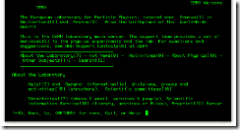Last week Chris Brogan wrote a post asking basically “What the Hell is Up with Second Life?” where he talks about his own uncertainty about the value of Second Life. It’s a good post to read, and has some great comments as well. I wound up posting my own comment to Chris – and then decided that it was a long enough commet that I should also just post it here. So here it is: (comments are of course welcome)
Chris,
Nice post… I think that, like you, many of us are trying to figure out what exactly Second Life means “in the big picture” of online communication.
To me the interesting aspect is that the combination of increasingly faster CPUs and increasingly ubiquitous broadband access has brought us to a space where we can actually interact with people in a “3-D” virtual world in something close to real time – and so Second Life represents to me an attempt at a newer interface for online communication and collaboration.
 If you go back to the late 1980s, the dominant interface on computer networks was text “terminal window” (vt100, telnet, whatever) and all the interfaces were entirely text-based. Going into the early 1990s probably the leading interface at the time was the menu-based (and text) gopher. I still remember one of the first versions of my “Introduction to the Internet” courseware I wrote then that had a final chapter on new and upcoming technologies which talked about this thing called “World Wide Web” which was access by telnetting to info.cern.ch and logging in as “www“. To follow a hypertext link you pressed the number on your keyboard that was after each link (see the image to the left).
If you go back to the late 1980s, the dominant interface on computer networks was text “terminal window” (vt100, telnet, whatever) and all the interfaces were entirely text-based. Going into the early 1990s probably the leading interface at the time was the menu-based (and text) gopher. I still remember one of the first versions of my “Introduction to the Internet” courseware I wrote then that had a final chapter on new and upcoming technologies which talked about this thing called “World Wide Web” which was access by telnetting to info.cern.ch and logging in as “www“. To follow a hypertext link you pressed the number on your keyboard that was after each link (see the image to the left).
Then came 1993 and the introduction of NCSA’s Mosaic browser which fundamentally changed the user interface paradigm. Suddenly you could use your mouse! (Gasp!) And…. you could have *images* on the same page as text! Of course network connections (and PCs) were far slower then, so image-laden pages sometimes took forever to load, but it was a huge improvement over the text-only world. (Which, folks from that era may recall, was why Netscape was such a huge immediate hit – it introduced the progressive loading of images.)
While the browsers we use have evolved substantially and brought in all sorts of added functionality, the reality is that we’re still using the same basic user interface we had 14 years ago. And so the hunger and hunt is for what is the *next* evolution of the ubiquitous online interface. Enter Second Life as the latest poster child for what *might* be the next interface.
We’ve been experimenting with virtual worlds since the early days of the Net… we’ve had MUDs and MOOs and all sorts of things. We’ve been trying “3-D” for ages, too. (Anyone remember VRML?) What I think is happening now is that the intersection of increased computing power and increased network speed, along with an incredibly massive number of people online (out of which to draw more early adopters and experimenters), has brought us to the point where we can actually think realistically about a richer collaboration/commmunication user interface than that of the web browser.
Will the end result be the interface of Second Life? Will it be one of the other contenders being introduced on almost a daily basis these days? Will it evolve out of one of the games like World of Warcraft? Will it be some combination of all of the above?
I think those are the questions… and the reasons why I, too, put up with the clumsy controls, technical issues, annoying avatar name restrictions and other, um, “challenges” of Second Life. I think of it as “Internet 3-D interface version 0.4” (or 0.04? or 0.004?) and am intrigued to see how it evolves.
P.S. Maybe one of these weeks I’ll catch you at Coffee with Crayon. I went for a number of weeks but haven’t been able to attend recently.